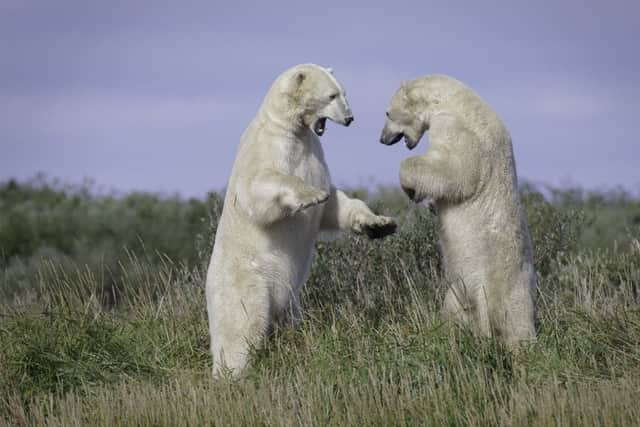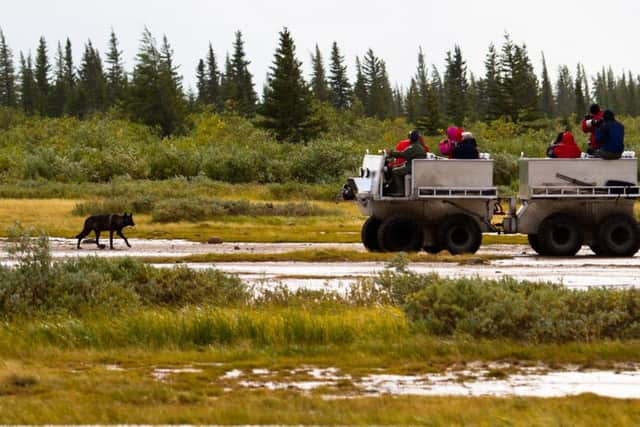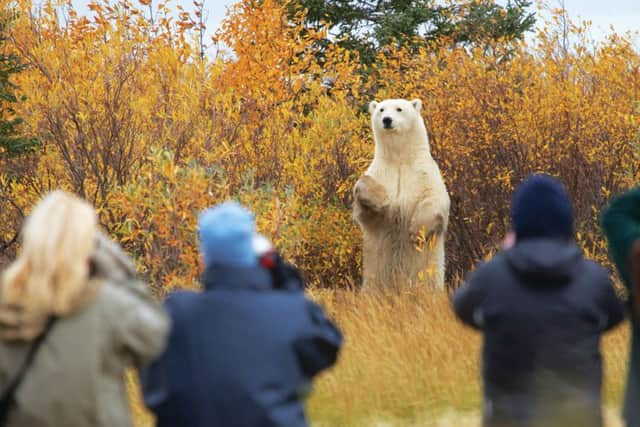Travel: On safari with a polar bear in the Arctic


Most people would walk away from a wild polar bear, not towards one. A few feet in front of me stood a massive, off-white, female with her plump two-year-old cub. A few minutes previously, I had stepped into the mother’s deep paw print, which swallowed up my size five boot.
Tripping across black muddy ground in single file with the Hudson Bay less than 200 metres away, we had made our way towards the bears. Every so often, our expert polar bear guide, Andy MacPherson, had stopped to assess the situation.
Advertisement
Hide Ad“Keep your eyes open at all times. Something unexpected always happens,” he said. “Be cautious, move slowly, and keep your voices down and camera flashes off.”


It was late August, and I’d come to this raw and remote stretch of marshy Arctic land on Hudson Bay (approximately 250km southeast of Churchill town) to experience the ultimate polar bear adventure: Hudson Bay Odyssey. The trip focuses on mothers and their cubs, and is an adrenaline fuelled “up close” walking safari with Churchill Wild, based at their Nanuk Polar Bear Lodge.
Churchill is a small Canadian sub-Arctic outpost 1,100km north of Winnipeg – the vibrant capital city of Manitoba province, known as the polar bear capital of the world. The seasonal polar bear population in the region is around 1,000, possibly more, and many are territorial, returning annually. Polar bears are only found in the Arctic, and as the ice disappears from Hudson Bay in late August, the local bears swim to shore and look for berries, fish and whales, while they wait for the ice to reform so they can hunt seals. Only the females will travel many kilometres inland to make birthing dens.
MacPherson has 26 years of wildlife guiding under his belt and has been ten years with Churchill Wild, one of the only companies offering eye-to-eye, on-the-ground polar bear experiences at four lodges in the region. Over 23 years ago, Mike Reimer, owner and founder of Churchill Wild, pioneered polar bear walking safaris. “Almost everybody in the area of Churchill had walked with bears at some point, and I wanted to open this up to visitors,” he says. “I hired guides, photographers and set up the business, working relentlessly to create a safe operation.”
Two-thirds of the world’s estimated 25,000-30,000 polar bears live in Canada where ice formation and plankton feed the fish, which feed the seals and whales, which feed the bears. Because bears need seals to survive, they don’t usually head too far north in the Arctic basin.


My journey had started at Churchill’s airport, where I clambered on board a small twin otter plane that carried me south along the rugged shore of Hudson Bay then above the windswept coast of Wapusk National Park, where we dropped low over the bay full of white beluga whales. I counted 12 solo polar bears stealthily patrolling the shore for food in the form of fatty seals or beluga whales too close to shore.
Advertisement
Hide AdAs we landed outside the perimeter fence of the Nanuk Polar Bear Lodge, a small black bear patrolling the dirt landing strip was shooed away by our second guide, Butch, a Cree from one of the largest First Nations groups of North America.
Once a remote duck hunting lodge, Nanuk is now a comfortable wildlife observation camp overlooking the Hudson Bay. Eight rooms lead off a central lounge and dining area, where we gathered for meals, talks and the obligatory bear safety briefing on arrival. We were warned that polar or black bears can show up at any time, to avoid the fences at night, and always be with a guide if venturing out at night to watch the Northern Lights – it doesn’t take much for an inquisitive bear to push the fence down.
Advertisement
Hide AdWe were remote, but didn’t slum it. Skilled chefs prepared delicious meals, with a focus on local food that had been flown in, including lake trout followed by blueberry cream cheese tart and freshly picked wild strawberries – a polar bear favourite. Generally, Nanuk Polar Bear Lodge shuts down on 20 November when the bay starts freezing and the bears head off across the ice, although climate change means the ice comes later and dates change.


The following morning we set off in the Rhino, a bespoke, open-topped aluminium vehicle with lightweight tractor tyres that can travel across the Arctic tundra come rain, sun, ice or snow, with 360-degree views. At first we mistook large white rocks in the distance for sleeping bears, then learned that a bear’s coat reflects a halo of light. Other wildlife lurked in the scrub bush: wolverines, wolves, black bears and caribou. Far in the distance, a white blob was spotted. We drove closer, then leapt off the Rhino to track the bear on foot.
We stopped 50m from a big male bear. It stood up and sauntered towards us, decreasing the 50m minimum limit to around 20m, then stopped, observing us with little black eyes set in a big broad head. I was aware of the huge canines capable of ripping large animals in half. Thankfully the bear lay down for a snooze in front of us, and we documented its form for over an hour, until it got up, came closer, then slowly walked away.
As our group outnumbered the bear, he made no attempt to harm us. Had I been alone, he would have surely considered me a tasty morsel. As a deterrent our guides carry stones, firecrackers, a pepper-based bear spray and, as a last resort, a 12-gauge shotgun – which they’ve never had to use. I felt safe with Butch and Andy, who have years of experience and can interpret the bears’ body language.
Nolan Booth, director of operations at Nanuk Lodge, says, “Bears live in a silent world. You are walking with something you are not meant to walk with. They are curious, and come to see what you are up to, and can be very dangerous,” he says. “The approach today was textbook: the male bear wasn’t scared, it didn’t run away, it just lay there, and so we felt OK to take people closer. The bear then decided to walk away. I get up many times at night to check the fences and make sure everyone is safe. We keep guests safe and bears safe, and that’s why we can keep doing this. Once you think you know it all, that’s when you get into trouble.”


My days were filled with incredible bear experiences as our group was guided on foot towards distant white blobs, always with experienced and armed guides. Bears sparred, dozed, foraged and played with their cubs right in front of us. If the excitement of bears, belugas and black wolves was not enough, at night we were treated to a stunning display of the Aurora Borealis. Along with patience, bring warm clothing for those drawn out moments that, in a flash, can turn into an exhilarating experience you’ll never forget. And always have your camera ready.